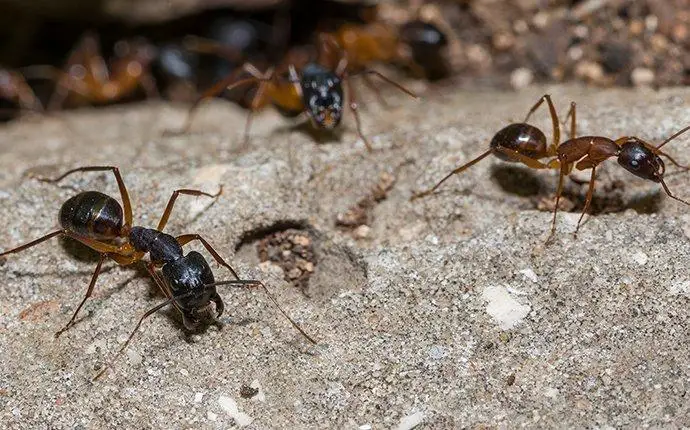
1. Carpenter Ants Don’t Eat Wood
You might think that carpenter ants eat wood if you’ve found carpenter ant damage. The tunnels they create in wood are very similar to termites’. But the amount of damage carpenter ants do isn’t even in the same ballpark. Termites cost U.S. property owners billions of dollars each year. The cost of carpenter ants is in the hundreds of millions.
2. Carpenter Ants Produce Sawdust
Carpenter ants shave wood with their mouthparts and push the sawdust out of tiny kickout holes. They do this to create galleries for their nests. If you have a carpenter ant infestation, you might see this material (which is referred to as frass). Subterranean termites (the termites that damage Raleigh properties) don’t produce frass. This is why they are far more destructive to homes and businesses in Raleigh than carpenter ants.
3. Carpenter Ants Don’t Tunnel In All Types Of Wood
How bad a carpenter ant infestation will be for you directly correlates to how much moisture damage or unprotected wood you have on your property. Carpenter ants are drawn to old or rotting wood. Here are a few “soft” targets they’ll zero in on.
- Stumps
- Logs
- Trees with heart rot
- An old wooden fence
- An unpainted deck
- A pile of firewood or lumber
If you don’t have any soft targets on your property, you’ll have fewer issues with carpenter ants.
4. Carpenter Ants Can Tunnel In Pressure-Treated Wood
There is one way carpenter ants are worse than termites. When they get into soft, rotting wood on a home, they can work their way into sound timbers. These timbers are often pressure-treated wood, which can kill termites but have little or no impact on carpenter ants. Why? Because carpenter ants don’t consume wood. For this reason, it is important to make an effort to seal gaps and cracks in your exterior so that carpenter ants can’t get in and target the frame of your home. If they find a way in, they cause a lot of damage over time. This can be bad.
5. Winged Carpenter Ants Can Appear Inside
When subterranean termites attack your property, they will do so from a ground nest. When carpenter ants attack your property, they will live on the inside. So it is more likely for winged carpenter ants to accidentally emerge inside. Winged termites most often exit outside. If you see winged termites in your home, it is a warning sign of a severe infestation because it means the colony is very close to your home. The likely appearance of winged carpenter ants in your home can alert you to the threat and lead you to take action if you are aware of the fact that they are a warning sign. If you suck them up with a vacuum and call it a day—well—that’s problematic.
6. Carpenter Ants Are More Likely To Create Visible Damage
Subterranean termites can be a significant threat to your property because the damage they do is almost exclusively on the inside of wood. This is because worker termites avoid dry air and light sources. Carpenter ants have no such aversions. While they’re nocturnal, they’re not repelled by light. And while they prefer moist and humid environments, they can come out into the air without fear of dying. So it is possible to see damage carpenter ants are doing to your property. You might notice a hole developing in a window or door frame. You may see a board in your deck deteriorating. You may see a rafter in your attic that is splintering. If you see changes to the wood of your home, contact a licensed professional and have your home inspected for wood-destroying organisms.
How Bad Are Carpenter Ants?
If carpenter ants attack your property, it is going to take years for them to do significant damage and you may see warning signs before you find yourself faced with a giant repair bill. The only concern is when all the conditions work against you. If carpenter ants find wet, rotted wood under a porch and create a nest in the structural timbers, they could leave sawdust where you can’t easily see it, and they could release swarmers underneath your home, rather than inside. This can allow them to damage your property until you start to see the floor sink and the doors start to stick. That’s bad. Not meteor-heading-toward-the-planet bad, but pretty bad.
It is best to not wait until your home is damaged by these insects. Reach out to Innovative Pest Solutions and learn about our year-round residential pest control plans. It pays to have routine visits from a licensed pest control professional. We can help you catch pest threats before the damage is done.




